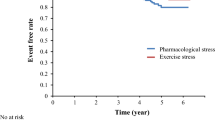Summary
The analysis of wall motion abnormalities with dobutamine stress echocardiography is an established method for the detection of myocardial ischemia. With ultrafast magnetic resonance tomography, the application of identical stress protocols as used for echocardiography is possible.
In 208 consecutive patients (147 M, 61 F) with suspected coronary artery disease, dobutamine stress echocardiography partially using harmonic imaging and dobutamine stress magnetic resonance tomography (DSMR) were performed prior to cardiac catheterization. DSMR images were acquired during short breath holds in 3 short axis-, a 4-, and a 2-chamber view using a turbo gradient echo technique. Patients were examined at rest and during a standard dobutamine-atropine scheme until submaximal heart rate was reached. Regional wall motion was assessed in a 16 segment model. Significant coronary heart disease was defined as angiographic ≥50% diameter stenosis.
With DSMR, significantly more patients yielded very good (69%) or good (13%) image quality in comparison with dobutamine stress echocardiography (20% and 31%, p<0.05). Moderate image quality occurred in 16% with MR and 41% with dobutamine stress echocardiography (p<0.05), 2% and 8% were non-diagnostic. With each technique 18 patients could not be examined (DSE: emphysema: 10, adipositas: 8, DSMR: claustrophobia: 11, adipositas: 6, contraindication: 1). Four patients did not reach target heart rate. In 107 patients, significant coronary artery disease was found. With DSMR sensitivity was 88.7% (dobutamine stress echocardiography: 74.3%; p<0.05) and specificity 85.7% (dobutamine stress echocardiography: 69.8%; p <0.05). This difference was most pronounced in the group with moderate echocardiographic image quality.
High dose DSMR is superior to dobutamine stress echocardiography and can replace this technique especially in patients with moderate echocardiographic image quality.
Zusammenfassung
In den letzten Jahren hat sich die Dobutamin-Streßechokardiographie als eine Standardmethode zur nichtinvasiven Ischämiediagnostik etabiert. Mit ultraschneller Magnetresonanztomographie können identische pharmakologische Streßprotokolle, wie derzeit in der Echokardiographie angewandt, durchgeführt werden.
Bei 208 konsekutiven Patienten (147 M, 61 F) mit Indikation zur Koronarangiographie bei Verdacht auf koronare Herzerkrankung wurden präinvasiv eine Dobutamin-Streßechokardiographie teils mit harmonic imaging und eine Dobutamin-Streßmagnetresonanztomographie (DSMR) (1,5 Tesla) durchgeführt. DSMR-Bilder wurden während kurzer Luftanhaltemanöver in 3 Kurzachsen, einem 4- und einem 2-Kammer-Blick in Gradientenechotechnik erstellt. Die Untersuchung der Patienten erfolgte in Ruhe und während einer Standard-Dobutamin-Atropin-Belastung bis zum Erreichen der Zielherzfrequenz. Die regionale Wandbewegung wurde in 16 Segmenten auf das Auftreten von Wandbewegungsstörungen analysiert. Eine koronare Herzerkrankung wurde als angiographische Reduktion des Gefäßdurchmesser von ≥50% definiert.
Mit der DSMR konnte in signifikant mehr Patienten eine sehr gute (69%) oder gute (13%) Bildqualität erreicht werden als mit der Dobutamin-Streßechokardiographie (20% und 31%, p<0,05). Eine mäßige Bildqualität trat mit der MRT in 16% und mit der Dobutamin-Streßechokardiographie in 41% auf (p<0,05), nicht diagnostisch waren 2% bzw. 8% der Untersuchungen. Mit der DSE und der DSMR konnten jeweils 18 Patienten nicht untersucht werden (DSE: Lungenemphysem: 10, Adipositas: 8; DSMR: Klaustrophobie:11, Adipositas: 6, Kontraindikation: 1). Die Sensitivität betrug für DSMR 88,7% (Dobutamin-Streßechokardiographie=74,3%; p<0,05), die Spezifität 85,7% (Dobutamin-Streßechokardiographie=69,8%; p<0,05). Dieser Unterschied war insbesondere in der Subgruppe mit mäßiger echokardiographischer Bildqualität nachzuweisen.
Die Dobutamin-Streßmagnetresonanztomographie ist der Dobutamin-Streßechokardiographie signifikant überlegen und kann diese insbesondere bei mäßiger echokardiographischer Bildqualität ersetzen.
Similar content being viewed by others
Author information
Authors and Affiliations
Additional information
Eingegangen: 21. Januar 1999, Akzeptiert: 20. Mai 1999
Rights and permissions
About this article
Cite this article
Nagel, E., Lehmkuhl, H.B., Klein, C. et al. Einfluß der Bildqualität auf die Genauigkeit der nichtinvasiven Ischämiediagnostik mit der Dobutamin-Streßmagnetresonanztomographie im Vergleich zur Dobutamin-Streßechokardiographie. Z Kardiol 88, 622–630 (1999). https://doi.org/10.1007/s003920050337
Issue Date:
DOI: https://doi.org/10.1007/s003920050337




